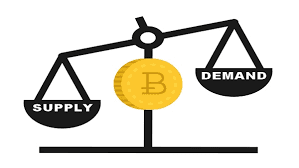Bitcoin Demand Vs Supply
Bitcoin Demand Vs Supply
When rumors surfaced of a possible glitch in the blockchain system supporting Bitcoin, buying interest in the mega crypto briefly waned. In all markets, any seed of doubt, especially in a still nascent, somewhat hard-to-understand asset, will send some investors to the sidelines. This is what happened for about a week in the Bitcoin markets, and prices pulled back. But when instability hit trading platforms in the wake of the Reddit-inspired investing frenzy in heavily shorted securities, resurgent demand for Bitcoin popped prices back up towards their all-time highs, largely because Bitcoin supply did not increase rapidly enough to meet demand.
The “double-spend” Bitcoin rumors were unequivocally proven false, stemming from a naturally occurring but extremely rare bifurcation in the resolution system for blockchain transactions that basically self-corrects as blockchain activities progress.
Market prices decline when there is a lack of demand; buyers pull back and those needing to sell, being more motivated for whatever reason, have to chase prices lower in order to cash in their holdings. In Bitcoin’s case, the double-spend rumors temporarily chased buyers away and left those needing to sell searching for buyers at lower prices. When the sellers had completed their initial round of selling, prices for Bitcoin had dropped around 15% from their peak in the early morning hours of January 20, 2021, to their trough in the evening of January 21, 2021. This is what happens when demand for something dries up. Prices go lower.
What Determines Bitcoin's Price?
Bitcoin is a cryptocurrency developed in 2009 by Satoshi Nakamoto, the name given to the unknown creator (or creators) of this virtual currency. Transactions are recorded in a blockchain, which shows the transaction history for each unit and is used to prove ownership.
Contrarily, bitcoin prices are influenced by the following factors:
Supply and Demand
Countries without fixed foreign exchange rates can partially control how much of their currency circulates by adjusting the discount rate, changing reserve requirements, or engaging in open-market operations. With these options, a central bank can potentially impact a currency’s exchange rate.
The supply of bitcoin is impacted in two different ways. First, the bitcoin protocol allows new bitcoins to be created at a fixed rate. New bitcoins are introduced into the market when miners process blocks of transactions, and the rate at which new coins are introduced is designed to slow over time. For example, growth slowed from 6.9% (2016), to 4.4% (2017) to 4.0% (2018).1 This can create scenarios in which the demand for bitcoins increases at a faster rate than the supply increases, which can drive up the price. The slowing of bitcoin circulation growth is due to the halving of block rewards offered to bitcoin miners and can be thought of as artificial inflation for the cryptocurrency ecosystem.
Secondly, supply may also be impacted by the number of bitcoins the system allows to exist. This number is capped at 21 million, where once this number is reached, mining activities will no longer create new bitcoins. For example. the supply of bitcoin reached 18.587 million in December 2020, representing 88.5% of the supply of bitcoin that will ultimately be made available. Once 21 million bitcoins are in circulation, prices depend on whether it is considered practical (readily usable in transactions), legal, and in demand, which is determined by the popularity of other cryptocurrencies.
Competition
While bitcoin may be the most well-known cryptocurrency, there are hundreds of other tokens vying for user attention. While bitcoin is still the dominant option concerning market capitalization, altcoins including Ethereum (ETH), Tether (USDT), Binance Coin (BNB), Cardano (ADA), and Polkadot (DOT) are among its closest competitors as of March 2021. Further, new initial coin offerings (ICOs) are constantly on the horizon due to the relatively few barriers to entry. The crowded field is good news for investors because the widespread competition keeps prices down. Fortunately for bitcoin, its high visibility gives it an edge over its competitors.
Investing in Bitcoin will remain interesting, challenging, and volatile because while Bitcoin’s ultimate supply is known and its rate of added supply is also known, demand is still the main variable that will move prices in the future. The events of the past 10 days have provided a valuable real-time lesson in supply and demand economics.




Comments